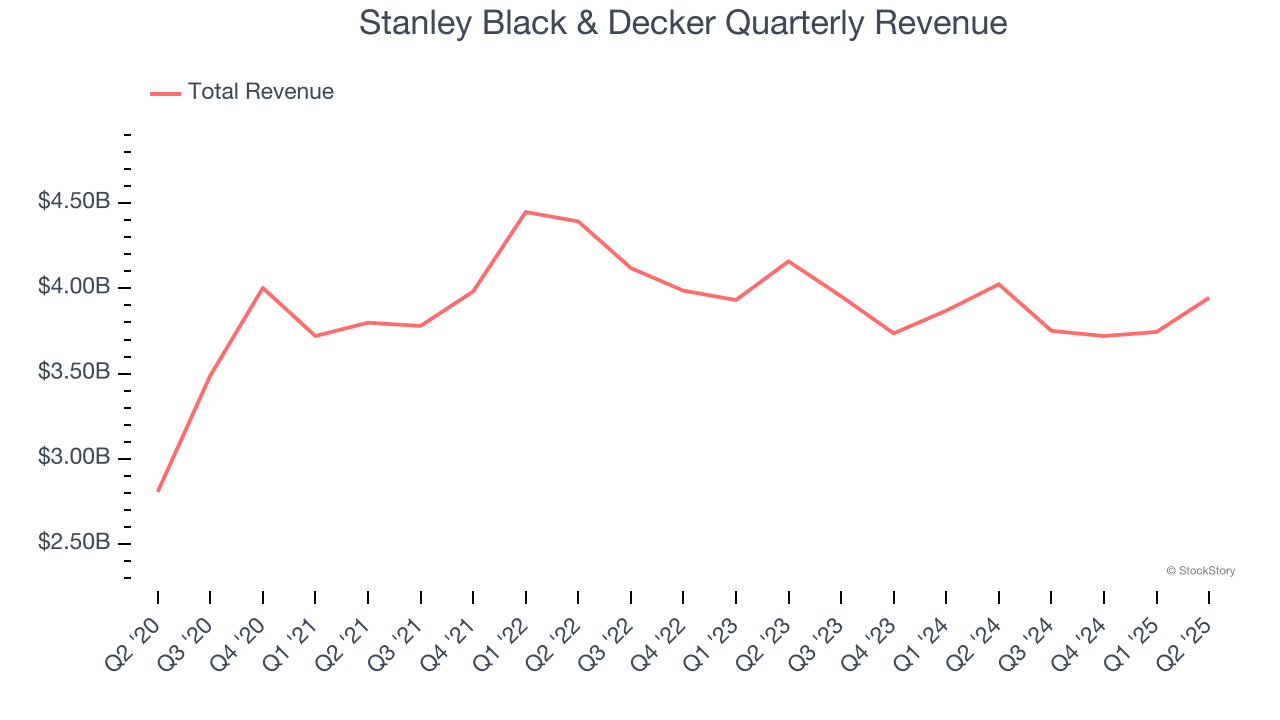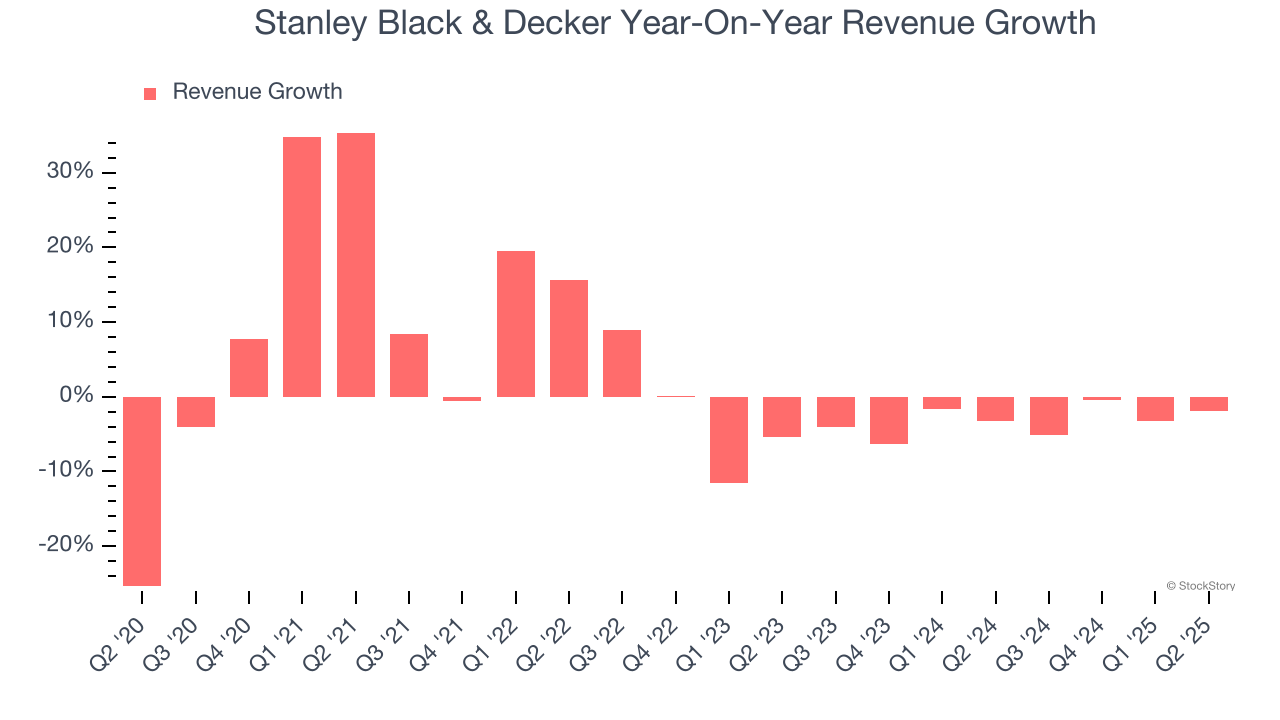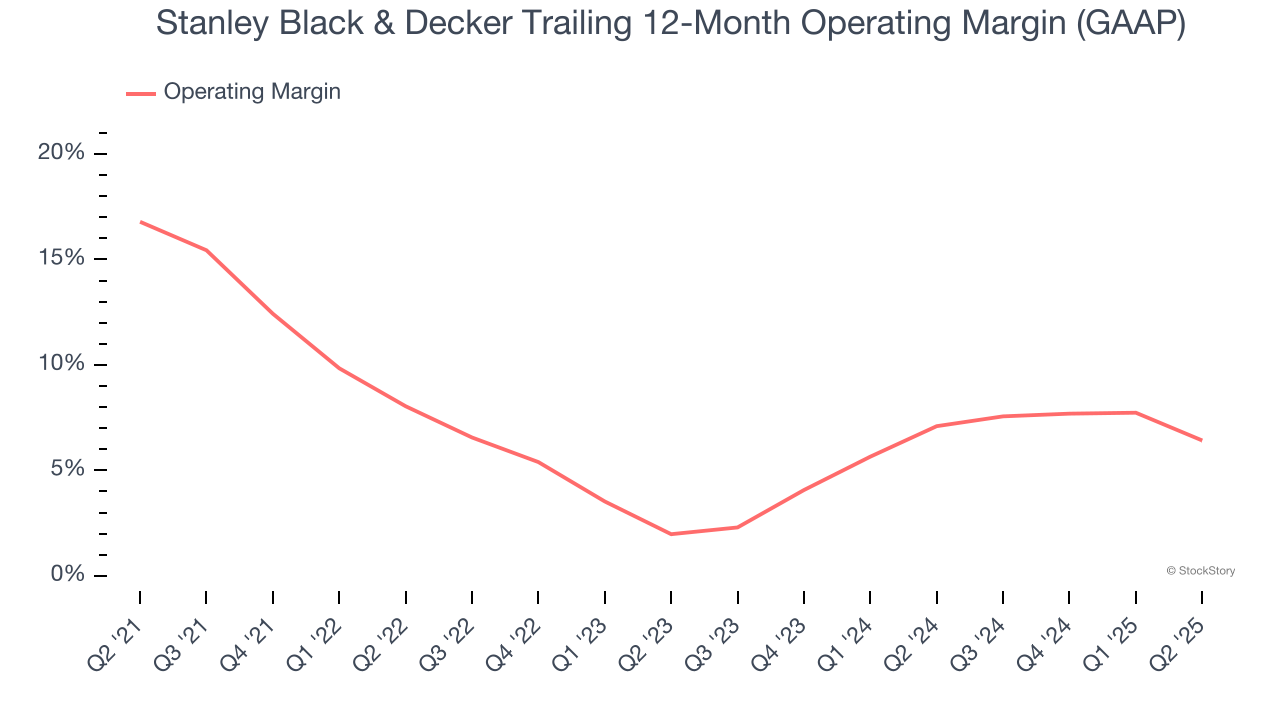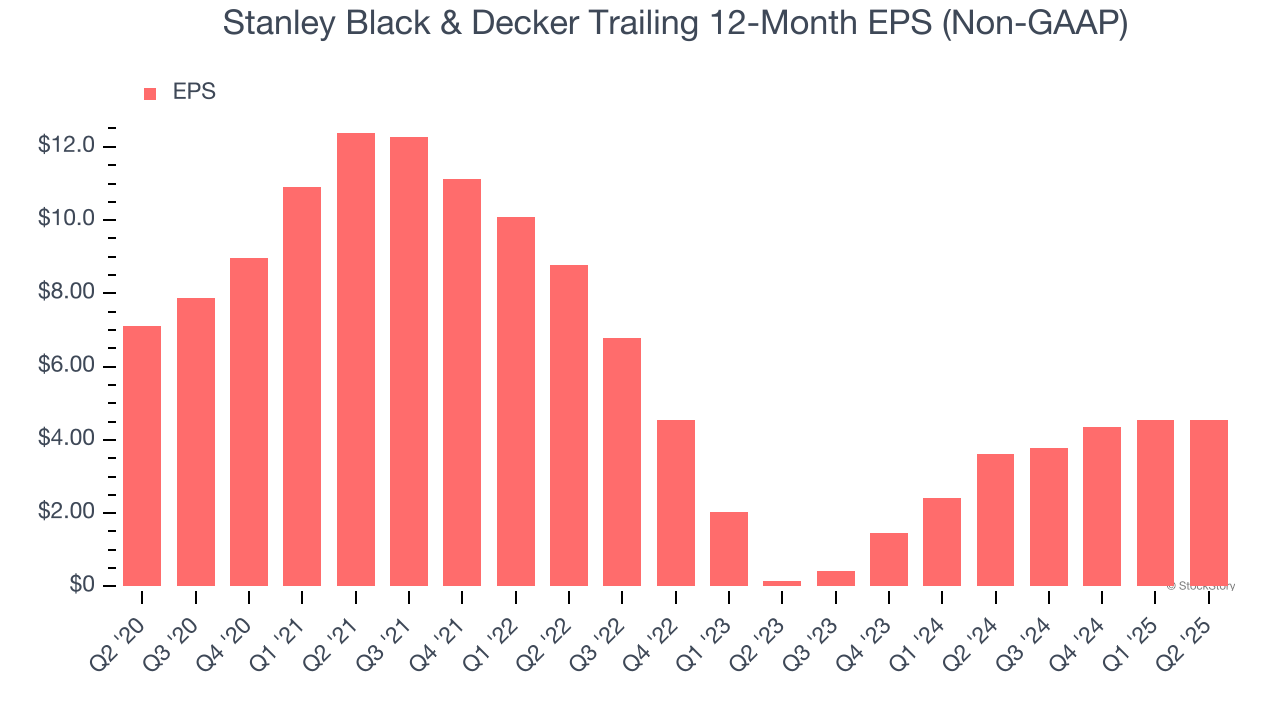
Manufacturing company Stanley Black & Decker (NYSE: SWK) fell short of the market’s revenue expectations in Q2 CY2025, with sales falling 2% year on year to $3.95 billion. Its non-GAAP profit of $1.08 per share was significantly above analysts’ consensus estimates.
Is now the time to buy Stanley Black & Decker? Find out by accessing our full research report, it’s free.
Stanley Black & Decker (SWK) Q2 CY2025 Highlights:
- Revenue: $3.95 billion vs analyst estimates of $4.01 billion (2% year-on-year decline, 1.7% miss)
- Adjusted EPS: $1.08 vs analyst estimates of $0.42 (significant beat)
- Adjusted EBITDA: $318.2 million vs analyst estimates of $313.8 million (8.1% margin, 1.4% beat)
- Adjusted EPS guidance for the full year is $4.65 at the midpoint, beating analyst estimates by 3.7%
- Operating Margin: 2.7%, down from 7.8% in the same quarter last year
- Free Cash Flow Margin: 3.4%, down from 12.1% in the same quarter last year
- Organic Revenue fell 3% year on year (1.1% in the same quarter last year)
- Market Capitalization: $11.44 billion
Donald Allan, Jr., Stanley Black & Decker's President & CEO, commented, "We delivered a solid second quarter amid the dynamic operating environment with the continued growth of our professional DEWALT brand. With our supply chain transformation on track to completion in 2025, we are positioning the Company to embark on the next chapter of delivering sustainable growth and long term shareholder returns. Stanley Black & Decker is built on the strength of our people, iconic brands and a powerful innovation engine – attributes that transcend external market conditions."
Company Overview
With an iconic “STANLEY” logo which has remained virtually unchanged for over a century, Stanley Black & Decker (NYSE: SWK) is a manufacturer primarily catering to the tool and outdoor equipment industry.
Revenue Growth
A company’s long-term sales performance can indicate its overall quality. Even a bad business can shine for one or two quarters, but a top-tier one grows for years. Regrettably, Stanley Black & Decker’s sales grew at a sluggish 3.3% compounded annual growth rate over the last five years. This fell short of our benchmark for the industrials sector and is a tough starting point for our analysis.

We at StockStory place the most emphasis on long-term growth, but within industrials, a half-decade historical view may miss cycles, industry trends, or a company capitalizing on catalysts such as a new contract win or a successful product line. Stanley Black & Decker’s performance shows it grew in the past but relinquished its gains over the last two years, as its revenue fell by 3.2% annually. 
Stanley Black & Decker also reports organic revenue, which strips out one-time events like acquisitions and currency fluctuations that don’t accurately reflect its fundamentals. Over the last two years, Stanley Black & Decker’s organic revenue averaged 1.7% year-on-year declines. Because this number is better than its normal revenue growth, we can see that some mixture of divestitures and foreign exchange rates dampened its headline results. 
This quarter, Stanley Black & Decker missed Wall Street’s estimates and reported a rather uninspiring 2% year-on-year revenue decline, generating $3.95 billion of revenue.
Looking ahead, sell-side analysts expect revenue to grow 5% over the next 12 months. While this projection indicates its newer products and services will catalyze better top-line performance, it is still below the sector average.
Unless you’ve been living under a rock, it should be obvious by now that generative AI is going to have a huge impact on how large corporations do business. While Nvidia and AMD are trading close to all-time highs, we prefer a lesser-known (but still profitable) stock benefiting from the rise of AI. Click here to access our free report one of our favorites growth stories.
Operating Margin
Operating margin is one of the best measures of profitability because it tells us how much money a company takes home after procuring and manufacturing its products, marketing and selling those products, and most importantly, keeping them relevant through research and development.
Stanley Black & Decker was profitable over the last five years but held back by its large cost base. Its average operating margin of 8% was weak for an industrials business. This result isn’t too surprising given its low gross margin as a starting point.
Looking at the trend in its profitability, Stanley Black & Decker’s operating margin decreased by 10.4 percentage points over the last five years. This raises questions about the company’s expense base because its revenue growth should have given it leverage on its fixed costs, resulting in better economies of scale and profitability. Stanley Black & Decker’s performance was poor no matter how you look at it - it shows that costs were rising and it couldn’t pass them onto its customers.

This quarter, Stanley Black & Decker generated an operating margin profit margin of 2.7%, down 5.1 percentage points year on year. Since Stanley Black & Decker’s operating margin decreased more than its gross margin, we can assume it was less efficient because expenses such as marketing, R&D, and administrative overhead increased.
Earnings Per Share
Revenue trends explain a company’s historical growth, but the long-term change in earnings per share (EPS) points to the profitability of that growth – for example, a company could inflate its sales through excessive spending on advertising and promotions.
Sadly for Stanley Black & Decker, its EPS declined by 8.6% annually over the last five years while its revenue grew by 3.3%. This tells us the company became less profitable on a per-share basis as it expanded due to non-fundamental factors such as interest expenses and taxes.

Diving into the nuances of Stanley Black & Decker’s earnings can give us a better understanding of its performance. As we mentioned earlier, Stanley Black & Decker’s operating margin declined by 10.4 percentage points over the last five years. This was the most relevant factor (aside from the revenue impact) behind its lower earnings; interest expenses and taxes can also affect EPS but don’t tell us as much about a company’s fundamentals.
Like with revenue, we analyze EPS over a shorter period to see if we are missing a change in the business.
For Stanley Black & Decker, its two-year annual EPS growth of 469% was higher than its five-year trend. This acceleration made it one of the faster-growing industrials companies in recent history.
In Q2, Stanley Black & Decker reported EPS at $1.08, down from $1.09 in the same quarter last year. Despite falling year on year, this print easily cleared analysts’ estimates. Over the next 12 months, Wall Street expects Stanley Black & Decker’s full-year EPS of $4.54 to grow 26.1%.
Key Takeaways from Stanley Black & Decker’s Q2 Results
We were impressed by how significantly Stanley Black & Decker blew past analysts’ EPS expectations this quarter. We were also glad its full-year EPS guidance trumped Wall Street’s estimates. On the other hand, its organic revenue missed, making this a weaker quarter. The stock traded down 4% to $70.97 immediately following the results.
Is Stanley Black & Decker an attractive investment opportunity at the current price? We think that the latest quarter is only one piece of the longer-term business quality puzzle. Quality, when combined with valuation, can help determine if the stock is a buy. We cover that in our actionable full research report which you can read here, it’s free.





